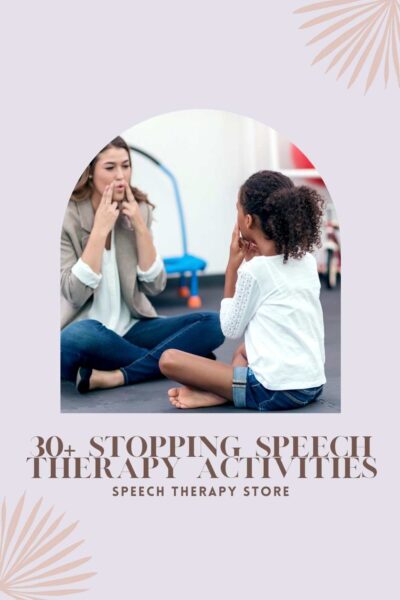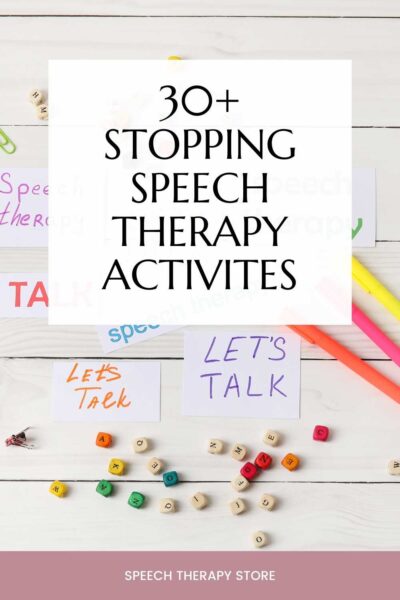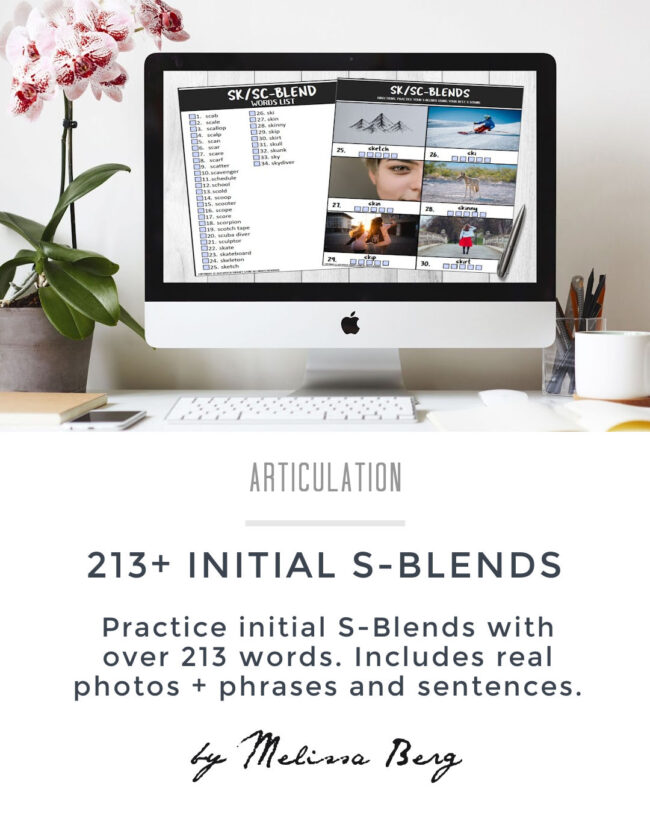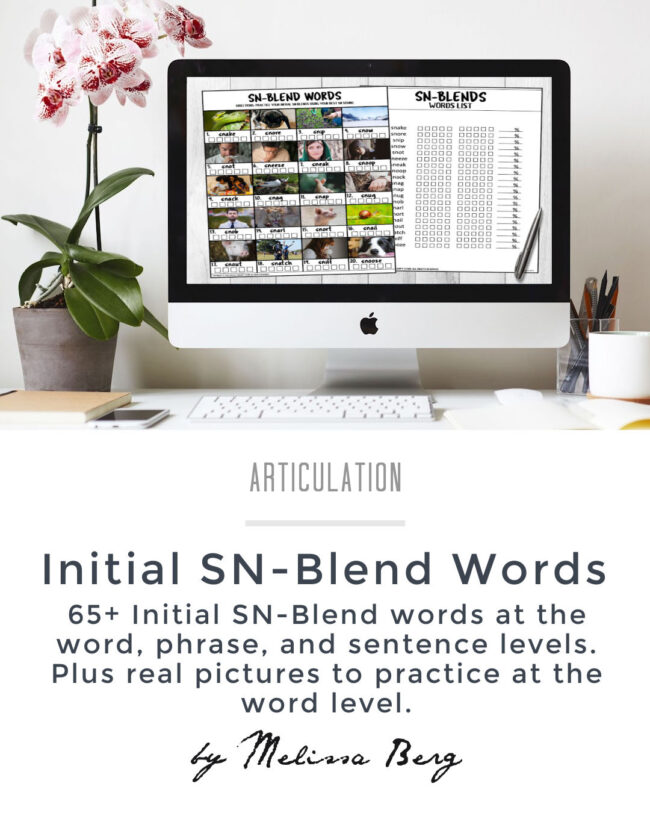I am beyond excited to bring you yet another great list of resources along with one amazing freebie of course. If you know me, crazy awesome freebies are my jam. This freebie includes a list of stopping speech therapy activities that you can use with your students.
Stopping is one of those very common phonological processes that most speech-language pathologists will have to work on at some point in their career.

Phonological Disorders
Phonological disorder speech problems are patterns of sound errors that children use to simplify speech as they are learning to talk.
Children will take complex words and simplify them in predictable ways to make words easier to pronounce until they can articulate the whole word correctly.
These speech production simplifications are called phonological processes.
If you’re like me and would love a handy little two-page PDF that covers ALL of the different speech therapy phonological error patterns, such as final consonant deletion, initial consonant deletion, or cluster reduction just to name a few then be sure to grab my complete list for easy reference.
Unlike phonological disorders, articulation disorders are just one sound error with individual sounds and are not observed in any predictable pattern, but instead are incorrect sounds across words and each position of a word.

Stop Sound
Are you wondering what a stop sound is in the English language?
The phonological process of stopping is when a child produces a stop consonant /p, b, t, d, k, or g/ in place of a fricative /f, v, th, s, z, sh, ch/ or in place of an affricate sound /j/.
Stopping is considered a normal phonological process that is typically eliminated by 3-5 years of age.
Language Development
If you’re wondering which phonological sound patterns are normal and at what age you can expect that primary error pattern to be eliminated be sure to check out my list of typical and atypical phonological errors along with their expected age of elimination.

Speech-Language Pathology
If you’re looking for different ways to work on your child’s needs when it comes to their communication disorder of stopping I’ve outlined three different methods below.
Before just jumping right in be sure to consult with your child’s speech language pathologist as they will know which method will provide your child’s speech with the most significant improvement.
In addition, your child’s test results and language skills will help determine which phonological speech patterns to start with first.
3 Therapy Methods – Stopping Speech Therapy Activities
1. Minimal Pairs
The first thing I like to try when working with different phonological sound disorders is using minimal pairs for therapy.
Using minimal pairs in your therapy sessions can help your student hear the difference in the words and realize when they say the word slightly “off” they are actually saying a different word altogether.
For example, if you had the minimal pair words “peel” and “feel” you could then play a game with stickers where the student must request for you to “peel” a sticker off (this also works on language goals of describing as they have to ask for which sticker they want), such as a student could tell you “can you peel the blue star for me?”
If the child or student said “feel” instead you could then rub your arm or point to a picture of the word feel and say, “you said the word “feel” so I’m feeling my arm, it is so soft.” This will most likely cause the child or student to become confused. You can then explain that they said a different word.

SEE ALSO: The Best Handout for Phonological Processing Disorder Therapy
2. Auditory Bombardment
If a child is having a difficult time with their sound production then another strategy to reduce stopping for a speech sound disorder is using auditory bombardment.
Auditory bombardment is when the speech pathologists say a list of words containing the sound(s) the student is working on. This allows the child to hear the correct pronunciation of their sound or sounds.
When working with young children you could also send a list of words home for different family members to read the list of words aloud to provide the child with even more auditory bombardment at home.

3. Cycles Approach
The cycles approach, developed by Barbara Hodson, is typically used with children who are experiencing multiple phonological process errors. For example, a student who is experiencing more than just the phonological error of stopping could benefit from the cycles approach.
When using the cycles approach a student will work on one phonological error for a short period of time like 6 weeks. Next, they cycle on to another one of their phonological errors. They will then continue to cycle through to the next pattern for a short length of time until each phonological error is eliminated.
You can start the cycles approach at the word level and then work towards using their phonological pattern in conversational speech.
Target Words
Here are some of the primary patterns of different consonant sounds to target when reducing the phonological processing disorders of stopping.
- Initial /f/ vs /p/ – “feel” for “peel”
- Initial /s/ vs /t/ – “sick” for “tick”
- Initial /sh/ vs /t/ – “share” for “tear”
- Initial /ch/ vs /t/ – “chalk” for “talk”
- Initial /th/ vs /t/ – “thank” for “tank”
- Initial /th/ vs /p/ – “thin” for “pin”
If you need a list of words for each of these speech sounds be sure to check out my list of over 130 single words that are paired up to practice minimal pairs.
SEE ALSO: Stopping Phonological Process: What is it? [Free Worksheets]

31+ Stopping Speech Therapy Activities
Boom Cards
A great way to add some fun to your stopping therapy is to use boom cards.
- Free s/t Minimal Pairs Hide & Seek Speech – Thanksgiving Theme – Boom Cards™ PPT by Little Speech Shop is a fun, no prep game that can assist your entire caseload in practicing minimal pairs! This game is designed to generate multiple productions of minimal pairs, and is interactive!
- 2. Snowball Fight! – S/T Minimal Pairs by Boom Learning is an interactive boom card deck with pairs for initial and final s. This is always a fun one to play!
- 3. Auditory Discrimination S and T Minimal Pairs- Articulation Activity by Boom Learning is a fun game where silly monsters eat snacks and identify the correct word. It is aimed for pre-k through first graders.
- 4. Minimal Pairs: /f/-/p/ by Boom Learning is an interactive and engaging game for students to practice f and p.
Conversational Levels
Once a child or student in the school setting is able to produce the correct phonological process at the word, phrase level, and sentence level they can then move on to working at the conversational level.
- 5. Leveled Activities for the /sp/ Cluster by Next Step Speech and Language is a resource that includes 9 leveled and engaging activities for the /sp/ cluster!
Included in the activities are language skills like past tense verbs, sentence structure, parts of speech, responding to “what” questions, and summarizing using Wh questions.
Video Game
Another fun way to work on the stop consonant sound is with a fun video game.
- 6. Phonological Process Stopping /s, f, v, z, sh/ by Pink Cat Games is a group of 4-8 fun and interactive games to practice phonological stopping.
- 7. STOPPING: auditory discrimination & production for f/p, B/V, t/s, t/sh by Pink Cat Games is an option to choose from 4 games to practice stopping auditory discrimination and production.
- 8. Stopping minimal pairs by Pink Cat Games is a great resource to find video games for you students to play and practice stopping minimal pairs!
Pairs of Words
Using minimal pairs of words is a great way to work on the phonological process of stopping. I’ve gone ahead and gathered a few below for you.
- 9. Stopping Phonological Process: What is is? Is an amazing resource we created! Use our free worksheets to help your students!
- 10. Minimal pairs – P and F by Meecca and Speechie is a great printout to use to practice the minimal pairs p and f.
- 11. Minimal Pairs Activities for S and T FREEBIE by Activity Tailor can be used for articulation therapy and for supporting phonemic awareness. In this activity, students say and sort, say and dab, and answer What did you hear?
- 12. Christmas Cut & Say: Phonological Processes {FREE} by The Speech Buzz is a great Christmas-themed activity to practice phonological processes using minimal pairs! Cut and Say the 5 sets of minimal pairs on each worksheet.
- 13. Minimal Pairs: /θ/ and /t/ by Rachel’s Speech Goodies is a 2 page set of colorful flashcards to practice /th/ and /t/.
- 14. Minimal pairs – S and T by Meecca and Speechie is a great set of S and T minimal pair flashcards!
- 15. Minimal pairs – P and F by Meecca and Speechie is another great resource to use to practice drilling P and F minimal pairs. These flashcards are neat and colorful.
- 16. Minimal Pairs: voiced “th” /ð/ vs /d/ and voiceless “th” /θ/ vs /t/ by Taylored Speech Therapy is a great resource to use for high school students! This is straightforward articulation therapy.

SEE ALSO: 29+ Minimal Pairs Activities Speech Therapy
Picture Cards
Using picture stimuli either on a piece of paper or with google images is a great way to visually show your students the different words they are pronouncing.
- 17. Minimal pairs – CH and T by Meecca and Speechie is a great resource of picture cards for CH and T minimal pair words.
- 18. Initial S FREEBIE | Stopping Interactive Phonology Flashcards | Digital/No Print by Target Every Goal Speech Therapy is a clear set of flashcards that target stopping. Visual cues are paired with a sound for precise practice.
- 19. Minimal Pairs Stopping by Riley Scott is 4 pages of flashcards to practice stopping with your students.
- 20. /f/ vs /b/ Minimal Pair Flashcards by SaLT Resources by Laura is a great set of minimal pair flashcards that target F and B.
- 21. T/F minimal pairs by Working on my Words is a pdf of flashcards to practice phonological awareness of minimal pairs T and F.
S Blends
You can also use s blends or consonant clusters to show the child or student the different words they are saying. For example, using a stop sign versus a top or t-shirt. Below are a handful of resources I found on teachers pay teachers.
- 22. S-blend Near Minimal Pairs by Anne Dye is a list form of S blend minimal pairs. Cut them out and use as flashcards too!
- 23. /SW/ BLENDS Homework with minimal pairs by Gaia – Speech is a great simple worksheet. This is a good resource to easily send home to help parents practice with the students!
- 24. Squash the Spider! Don’t Spill the Cider! S Blend FREEBIE by Activity Tailor is a game that uses “spider” and “cider” for a fun, s articulation therapy activity.
- 25. S-Blend Cards (s-stops only) by Speech Therapy Tools are printable picture/word cards! Use them to facilitate the correct production of S – stop blends.
- 26. Free Winter Speech Therapy Dot Art: Consonant Cluster Reduction (S Blends) by Ausome Speech is really fun and interactive. Use this set of printable sheets to target consonant cluster reduction for S blends. There are so many different ways to use these sheets.
If you need s-blend articulation lists be sure to check out the following:
Younger Kids
Here are a few stopping speech therapy activities that are perfect for younger kids.
- 27. d/z Initial Minimal Pairs – Board Game by SpeechPathResources is a great game to make drill practice fun! This is a race themed board game.
- 28. Stopping of /f, s/ FREEBIE by Teach Speech 365 is a no-prep freebie! There are 3 sheets total with 5 pictures of minimal pairs on each to practice f and s.
- 29. Minimal Pairs Smash Mats for Articulation & Phonology FREEBIE by Jill Shook SLP is a fun smash mat activity that includes one mat for the following: Gliding, Fronting, Stopping, Cluster Reduction, and Final Consonant Deletion.
- 30. FREE Articulation Turkey Craft For /B, P, S, Z, T, D, F, V/ Speech Sounds by the SpeechScoop targets 8 speech sounds with a fun and interactive turkey craft!

End of a Word
If you need phonological stopping worksheets that focus on the end of a word be sure to check out the following resources.
- 31. Final Consonant Deletion Minimal Pairs – NO PREP Final K FREEBIE by Nurture Speech Pathology is a free pack of 46 no prep activity pack to practice final k sounds and decrease final consonant deletion.
- 32. Final Consonants Homework with End Sound Helper Cue by Panda Speech Therapy is a great resource for homework pages to practice final consonants!
- 33. Final Consonant Deletion Minimal Pairs- Christmas Theme by The SLT Scrapbook is 3 pages of final consonant deletion pairs of words. There are 15 in total.
In Conclusion – Stopping Speech Therapy Activities
If your child or student is making slow progress don’t give up sometimes it just takes little bits of practice to make a huge difference.
It can be as simple as a 10 min session with a lot of practice with one set of minimal pairs for example.
In addition, if you need some different articulation approaches and articulation word lists be sure to check out my complete section of articulation sounds with lots of practice words.
Grab Your Free Stopping Word List with Pictures Here!
Simply enter your name and email to have this free stopping words list with pictures emailed directly to your inbox!
See the Complete Stopping Word Lists Here!
Want Even More Stopping Speech Therapy Activities?
- Stopping Phonological Process: What is it? [Free Worksheets]
- The Best Handout for Phonological Processing Disorder Therapy
- 29+ Minimal Pairs Activities Speech Therapy
- 213+ S-Blends for Speech Therapy
Want the Best of the Bests?
Be sure to check out our most popular posts below!
- 21 Best Reinforcement Games for Speech Therapy / Teletherapy
- Best IEP Resources
- 71+ Free Social Problem-Solving Scenarios
- 430+ Free Multisyllabic Words List Activity Bundle
- 432+ Free Measurable IEP Goals and Objectives Bank
- 279+ Free Speech Therapy Digital Materials
- 179+ Free Speech Therapy Wh-Questions Printable



